Navigation
Install the app
How to install the app on iOS
Follow along with the video below to see how to install our site as a web app on your home screen.
Note: This feature may not be available in some browsers.
More options
You are using an out of date browser. It may not display this or other websites correctly.
You should upgrade or use an alternative browser.
You should upgrade or use an alternative browser.
Keeping Seahorses in Aquaria #1 - Introduction and Setting Up Your Seahorse Tank
- Thread starter vlangel
- Start date
- Tagged users None
I do not, although I did raise fry once. Maybe I will share an article on how I did that on down the road. Right now my life is full to take on any extra projects.vlangel, thanks for this info series. Very detailed and informative. Do you have a series on what to do when you get a breeding pair and they have babies?
I don't like that either. I have arranged with the owner of a lfs to take my babies for free. I keep my water around 70°F and my pair have not produced fry in a long time. Usually water closer to 74°F is more favorable for mating pairs.Thank you. Looking forward to it. My buddy is hounding me into adopting his breeding pair and I don't like the babies getting sucked into filters or accidentally eaten.
vetteguy53081
Well known Member and monster tank lover
View Badges
Partner Member 2024
Excellence Award
Reef Tank 365
RGB
Article Contributor
Tampa Bay Reef Keepers
West Palm Beach Reefer
Hospitality Award
Ocala Reef Club Member
305 Reef Club
Wisco Reefers
Midwest Reefer
Fish Medic
MAC of SW Florida
Rock Pool Reef Keepers
R2R Secret Santa 2023
My Tank Thread
My Aquarium Showcase
Well written and beautiful pictures !!
Seahorses are a wonderful concept and often an attention grabber. Many need to realize seahorses are slow moving and cannot dodge or avoid quick and aggressive tankmates. Tankmates are less favorable as seahorses being slow cannot compete for food and will stress and starve. Rather than scales, their body is made of armor .
They prefer live foods and eat copepods like candy.
They cannot tolerate fast moving water nor can they tolerate ammonia levels. Other than that, they are east care once you meet requirements , nor do they need a large tank - Just good water quality, something to cling onto so they are not suspended all the time in tank and food.
Seahorses are a wonderful concept and often an attention grabber. Many need to realize seahorses are slow moving and cannot dodge or avoid quick and aggressive tankmates. Tankmates are less favorable as seahorses being slow cannot compete for food and will stress and starve. Rather than scales, their body is made of armor .
They prefer live foods and eat copepods like candy.
They cannot tolerate fast moving water nor can they tolerate ammonia levels. Other than that, they are east care once you meet requirements , nor do they need a large tank - Just good water quality, something to cling onto so they are not suspended all the time in tank and food.
- Joined
- Dec 1, 2019
- Messages
- 2,694
- Reaction score
- 11,005
I know you wrote this awhile ago but I’m new to site and I’m a seahorse junkie. So far I loved pt 1 and can’t wait to bundle read the other 5. A couple of your quotes or sayings hit home with me. I’m so happy I ran across this thread
This article is the first in a 6-part series that is designed to help those of you who already have the knowledge and ability to keep marine life in an aquarium, but want to learn the particulars of keeping greater seahorses. I will be assuming that you already understand the cycling process, standard equipment function, and general maintenance practices of keeping an aquarium.
I also want you to know that I am sharing this information peer to peer, one hobbyist to another. I am not an expert on greater seahorses. Five years ago, I was in the place you are now. I was interested in setting up a tank for greater seahorses and was trying to learn how to do that. The information is available but it can be scattered here, there, and everywhere. It is my hope that this article along with the experience you already have as a saltwater aquarist will equip you to successfully keep seahorses.
How seahorses differ from other marine fish
Let’s begin by recognizing that seahorses do in fact differ from other saltwater fish. Some of these differences are quite obvious while others are not as apparent. Certainly their appearance is different with a head and neck that looks like a horse and a long prehensile tail! They also lack a caudal fin and do not have scales. They swim in an upright position as opposed to horizontally. These obvious differences intrigue and charm us but it is a subtler difference that requires the aquarist to treat seahorses differently when keeping them in an aquarium. Seahorses do not have the same immune response to pathogens as other marine fish. They are more vulnerable to both dangerous bacteria and parasites. They are at risk in 3 areas: their skin, their digestive tract and their respiratory system.
Remember that I stated that seahorses have skin rather than scales? This can be a disadvantage in an aquarium since scales on a fish act like a suit of armor on a soldier. It protects the fish from cuts, abrasions and puncture wounds from penetrating into the fish. Since seahorses do not have this protection, it is up to us, their keepers to be vigilant to protect them. That sounds easy but there is more to it than just removing all pinching crabs! For instance, a few years ago both my ponies came down with small bacterial infections at the base of their tails. I was at a loss as to what was causing the wounds. It turns out that a coco worm tube that they liked to use as a hitch had very sharp points on it from a tiny marine creature building its home there. When I took some sandpaper to the tube the injuries stopped. I have even read of asterina starfish leaving marks on seahorses. A seahorse keeper should get in the habit of inspecting the ponies in their herd for skin irregularities every day. The quicker a wound is caught the better the chance of healing it. The snouts and tails of seahorses are particularly important as they need these to eat and hitch.

A seahorse’s digestion and intestinal tract is simpler than most other marine fish. They have almost no stomach at all and as a result seahorses are not able to absorb as many nutrients from their food. That means in order to meet their energy needs they must eat a lot. The staple diet for our pet ponies is generally frozen mysis shrimp. Mysis shrimp is both high in protein and rich in fat. Now imagine your ravenous pony consuming large quantities of a high protein, fat rich food but not effectively processing it. It is only slightly better than dumping frozen mysis in the tank to rot! In fact, some of the frozen mysis does not get processed through digestion at all because seahorses can be very picky wasteful diners as well. They casually watch as perfectly good pieces of mysis just float away. This all contributes to an extremely heavy bioload on a seahorse tank system. Special precautions must be taken to deal with the bio-load and also the potential of trapped, decaying food that could fuel pathogenic bacteria in the display aquarium.

The last area of vulnerability has to do with a seahorse’s gill structure. Obviously, a seahorse’s head shape is vastly different than other fish and so there is not enough room to accommodate the same gill structure. A seahorse has tufted gills on a stem that are more prone to disease and parasites. Their gills are not as effective so they do not tolerate low oxygen levels or lack of gas exchange as well as most fish.
These 3 areas of vulnerability need to be factored in and compensated for when setting up an aquarium to keep seahorses. When measures have been taken to compensate for these weaknesses, then keeping seahorses as pets can be possible.
Setting up an aquarium for seahorses
Although I am not dictating this aquarium set up to be a “species specific” tank, the process will be the same as if seahorses were the only species to inhabit it. The litmus test must always be, “am I putting the needs of the seahorses before everything else”? Other fish and organisms can live in the seahorse tank if their needs do not compromise or jeopardize the ponies’ wellbeing. It can be very tempting to compromise just a little to accommodate another interesting organism, but speaking from personal experience, do not do it! Set up another tank or decide that seahorses are not for you.

The information that I will be giving is appropriate for the greater seahorse species H. Erectus, H. Reidi, H. Comes, H. Kuda and H. Barbouri seahorses. Other species may have differing needs.
Three considerations should be given thought when choosing a display tank. They are location, volume, and the dimensions. I will offer guidance in each of these considerations.
Let’s begin with where the tank will be set up. Seahorses can experience stress by loud noises, chaos, and vibrations. Stress can cause their immune system to be suppressed and since they are already at a disadvantage in that department, choose a reasonably quiet spot for their tank. I definitely would avoid your child’s playroom! Seahorse tanks need frequent bigger water changes to compensate for the heavy bioload they place on their systems. You will want close, easy access to water. Nothing dampens one’s enthusiasm for the hobby like lugging 5-gallon buckets of saltwater up the stairs and all the way across the house!
Once the decision is made where the aquarium will go, then you need to decide what size is appropriate. Conventional seahorse wisdom dictates that there should be 30 gallons of water for a pair of seahorses and 15 gallons for each additional seahorse. That may seem sparsely populated but again this is part of the compensation for all the bio-load they place on their systems. Using this stocking density as a guide helps the seahorse keeper to have time to rectify a problem, (should one occur) before tragedy strikes. The only time I would make an exception is when baby seahorses are being raised. Seahorses can have 200+ babies and that would be MTS (multiple tank syndrome) on steroids!
The dimensions of a seahorse display tank are important too. As stated earlier, seahorses swim in an upright position. To protect the herd from buoyancy issues, and to allow them the space for their mating ritual they should be in a tank at least 3 times their maximum height. Seahorses continue to grow their entire life and an erectus seahorse can grow to over 7” in length. Tanks that are 24” high are a good choice in most cases. A tank that is 24” high but has a small footprint however can pose a danger of not enough surface area to provide adequate gas exchange. To compensate for the pony’s gill structure, special attention must be placed on creating surface agitation and all the more so in a tall tank with a small footprint. To not heed this is to risk putting the ponies in respiratory distress or possible GBD (gas bubble disease) for any stallions.
That finishes the considerations regarding the seahorses’ well-being but there is one more decision that the aquarist must consider. Do you prefer an AIO (all in one) aquarium or an aquarium system with a sump? Some folks prefer the simplicity of little to no plumbing in an AIO. Others like being able to house and hide equipment in a sump. Both can work but be cautious of a manufactured AIO that comes with a light fixture in the hood. Too much heat is usually a problem for seahorses with these types of AIO aquariums.
More equipment
Lighting a seahorse aquarium is less complicated than filtration. Seahorses have excellent eyesight. The only health related issue that seahorses have regarding lights is the heat output. As long as the water temperature stays below 75 degrees, any aquarium light fixture can work. These days most seahorse keepers use LEDs or T5s. However, the old strip lights can works as well as PC (power compact) or VHOs (very high output). If heat issues are being addressed even Metal Halide is an option. That means that the choice is totally up to the aquarist’s preference. Sometimes the light fixture may be dictated by budget or by the needs of other livestock that share the aquarium with the ponies. Perhaps a particular light fixture gives a shimmer or intensity and spectrum that is pleasing to the aquarist’s eye. One consideration to note is that seahorses tend to color up more vibrantly if the tank is not lit up super intensely.
Temperature control is very crucial to a seahorse tank. The reason for this is to discourage dangerous bacteria. For every degree above 74 degrees Fahrenheit, the pathogenic bacteria will reproduce exponentially. The ideal temperature for the species I mentioned is between 70 and 74 degrees.
This does not necessarily require buying an expensive chiller but it might. Once the pumps and lights have been purchased, the tank should be set up and operated with water just as if the seahorses were in it. The lights should be on the same duration as they would be if ponies were in the tank. Then the temperature should be monitored. If it is going above 75 degrees, the aquarist can try running a fan over the surface of the water in the display tank or the sump to see if it will bring the temperature down a couple of degrees. If the temperature is staying at 74 to 70 degrees then you are probably ok. However, if the temperature is 75 degrees or higher, then a chiller should be purchased. Many folks have tried to keep seahorses in warmer temperatures but most without long-term success.
The one exception to this is if they only feed their ponies live foods. For most seahorse keepers, this is not economical or convenient. Frozen mysis shrimp is reasonably priced and convenient. Any uneaten frozen mysis however begins to decompose immediately. Once that process begins dangerous bacteria inhabit the decaying mysis very quickly in temperatures over 74 degrees. If a hungry pony, (and healthy ponies are always hungry ponies) finds the decaying mysis then they can get a bacterial infection of the gut. Keeping the temperatures in the 70 to 74-degree range discourages the dangerous bacteria from propagating and greatly reduces the chances of a seahorse succumbing to an infection of the gut.
I did not mention a heater as part of temperature control because overly warm water is generally more of a problem than cool water. If in monitoring the temperature, you find that your tank is cooler than 68 degrees, then I recommend a heater. Heaters are notorious for getting stuck on which can be devastating to any tank. If your tank needs a heater I suggest buying 2 small heaters rather than 1 large one.
My last ‘must have’ piece of equipment is a simple plug in battery backup aerator pump. They are less than $20 and have saved countless tanks from crashes when the electricity went off or a circuit was tripped. Be sure to get the pump that can detect an electrical failure, even when you are not at home. Often it seems these events happen when you are away or on vacation. They run on 2 D size batteries. I ritually replace the batteries every New Year’s along with the batteries for the smoke detectors.

That concludes all the necessary equipment items. Of course, there are many items that can be convenient or add safeguards to your seahorse tank by building in redundancy. These include UV sterilizers, reactors, controllers and ATO (auto top off) systems. These items can be wonderful and certainly offer peace of mind. They are not ‘must have’ items and my seahorse tank runs without any of them.
I began this article with how seahorses differ from other marine fish. In that section I mainly focused on physical and anatomical differences. There are other differences that are less concrete. These include personality and just a likable charisma that is difficult to explain unless you have experienced it. Seahorses have the ability to completely capture your heart with their utter adorableness. If you have been bitten and smitten by the seahorse bug, you won't be able to imagine life without them ever again!

To read the second article in this series, Keeping Seahorses in Aquaria #2 - Aquascaping and Providing Excellent Water Quality, follow this link.
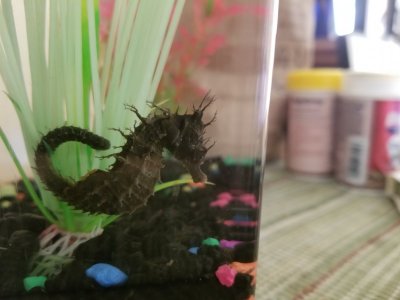
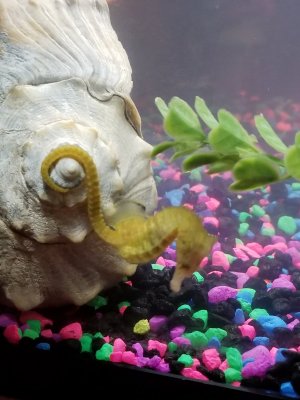
What’s your you tube my dudeExcellent article! They actually do have stomachs, but they definitely don't work like a normal one. I've started a YouTube channel to help accomplish the same thing (get correct and up-to-date information about seahorses available in easy to find places). I won't piggy back your article, I'm just thankful to see this happening in other places.
I love that you started the article focusing on their differing immune systems. I've been doing so much research about GALT and pathogen carriers that my head spins thinking about it. I'm headed to read the other articles, but hope you cover NSW and species only, as these seem to be the current debates between seahorse keepers.
This is a well written start up guide, that I wish had been around when I started.
https://www.youtube.com/channel/UCYuBGdyryDe5iUirUMI47yQ The Seahorse Whisperer, also on Facebook.
- Joined
- May 2, 2020
- Messages
- 116
- Reaction score
- 111
Thanks for taking the time to help protect our little friends. My passion is Dwarf Seahorses and they breed here with great success. The Filter and Nitrate problems you have with Seahorse feeding habits can be somewhat solved by using the Different Tank Build Filter Design. It is a Different Bio Filter Concept that is ideally sited to the problem of inefficient feeding. There are 750 gallons of Marine Pond here and 400 gallons of Fresh Water ponds. They all use the same Bio Fabric Filters. The Filter can reduce 145 ppm Nitrate to 5 ppm in 24 hours. It can reduce 7 ppm Nitrite to .1 ppm in the same time. The Technology can be added to any system by winding Bio Fabric Cores and putting them in a Phos Reactor hanging on the Tank. My Seahorse Tanks do not need Live Rock or Crushed Coral. They cycle in 7 days instead of 6 weeks. All this has been posted along with Test results. The Tulle Fabric Coral is just as valuable for Full Size Seahorses because it allows a very aggressive Cleaning Crew outside the Coral. The Tulle Fabric Coral Wall also harbors a large amount of live food.
This article is the first in a 6-part series that is designed to help those of you who already have the knowledge and ability to keep marine life in an aquarium, but want to learn the particulars of keeping greater seahorses. I will be assuming that you already understand the cycling process, standard equipment function, and general maintenance practices of keeping an aquarium.
I also want you to know that I am sharing this information peer to peer, one hobbyist to another. I am not an expert on greater seahorses. Five years ago, I was in the place you are now. I was interested in setting up a tank for greater seahorses and was trying to learn how to do that. The information is available but it can be scattered here, there, and everywhere. It is my hope that this article along with the experience you already have as a saltwater aquarist will equip you to successfully keep seahorses.
How seahorses differ from other marine fish
Let’s begin by recognizing that seahorses do in fact differ from other saltwater fish. Some of these differences are quite obvious while others are not as apparent. Certainly their appearance is different with a head and neck that looks like a horse and a long prehensile tail! They also lack a caudal fin and do not have scales. They swim in an upright position as opposed to horizontally. These obvious differences intrigue and charm us but it is a subtler difference that requires the aquarist to treat seahorses differently when keeping them in an aquarium. Seahorses do not have the same immune response to pathogens as other marine fish. They are more vulnerable to both dangerous bacteria and parasites. They are at risk in 3 areas: their skin, their digestive tract and their respiratory system.
Remember that I stated that seahorses have skin rather than scales? This can be a disadvantage in an aquarium since scales on a fish act like a suit of armor on a soldier. It protects the fish from cuts, abrasions and puncture wounds from penetrating into the fish. Since seahorses do not have this protection, it is up to us, their keepers to be vigilant to protect them. That sounds easy but there is more to it than just removing all pinching crabs! For instance, a few years ago both my ponies came down with small bacterial infections at the base of their tails. I was at a loss as to what was causing the wounds. It turns out that a coco worm tube that they liked to use as a hitch had very sharp points on it from a tiny marine creature building its home there. When I took some sandpaper to the tube the injuries stopped. I have even read of asterina starfish leaving marks on seahorses. A seahorse keeper should get in the habit of inspecting the ponies in their herd for skin irregularities every day. The quicker a wound is caught the better the chance of healing it. The snouts and tails of seahorses are particularly important as they need these to eat and hitch.

A seahorse’s digestion and intestinal tract is simpler than most other marine fish. They have almost no stomach at all and as a result seahorses are not able to absorb as many nutrients from their food. That means in order to meet their energy needs they must eat a lot. The staple diet for our pet ponies is generally frozen mysis shrimp. Mysis shrimp is both high in protein and rich in fat. Now imagine your ravenous pony consuming large quantities of a high protein, fat rich food but not effectively processing it. It is only slightly better than dumping frozen mysis in the tank to rot! In fact, some of the frozen mysis does not get processed through digestion at all because seahorses can be very picky wasteful diners as well. They casually watch as perfectly good pieces of mysis just float away. This all contributes to an extremely heavy bioload on a seahorse tank system. Special precautions must be taken to deal with the bio-load and also the potential of trapped, decaying food that could fuel pathogenic bacteria in the display aquarium.

The last area of vulnerability has to do with a seahorse’s gill structure. Obviously, a seahorse’s head shape is vastly different than other fish and so there is not enough room to accommodate the same gill structure. A seahorse has tufted gills on a stem that are more prone to disease and parasites. Their gills are not as effective so they do not tolerate low oxygen levels or lack of gas exchange as well as most fish.
These 3 areas of vulnerability need to be factored in and compensated for when setting up an aquarium to keep seahorses. When measures have been taken to compensate for these weaknesses, then keeping seahorses as pets can be possible.
Setting up an aquarium for seahorses
Although I am not dictating this aquarium set up to be a “species specific” tank, the process will be the same as if seahorses were the only species to inhabit it. The litmus test must always be, “am I putting the needs of the seahorses before everything else”? Other fish and organisms can live in the seahorse tank if their needs do not compromise or jeopardize the ponies’ wellbeing. It can be very tempting to compromise just a little to accommodate another interesting organism, but speaking from personal experience, do not do it! Set up another tank or decide that seahorses are not for you.

The information that I will be giving is appropriate for the greater seahorse species H. Erectus, H. Reidi, H. Comes, H. Kuda and H. Barbouri seahorses. Other species may have differing needs.
Three considerations should be given thought when choosing a display tank. They are location, volume, and the dimensions. I will offer guidance in each of these considerations.
Let’s begin with where the tank will be set up. Seahorses can experience stress by loud noises, chaos, and vibrations. Stress can cause their immune system to be suppressed and since they are already at a disadvantage in that department, choose a reasonably quiet spot for their tank. I definitely would avoid your child’s playroom! Seahorse tanks need frequent bigger water changes to compensate for the heavy bioload they place on their systems. You will want close, easy access to water. Nothing dampens one’s enthusiasm for the hobby like lugging 5-gallon buckets of saltwater up the stairs and all the way across the house!
Once the decision is made where the aquarium will go, then you need to decide what size is appropriate. Conventional seahorse wisdom dictates that there should be 30 gallons of water for a pair of seahorses and 15 gallons for each additional seahorse. That may seem sparsely populated but again this is part of the compensation for all the bio-load they place on their systems. Using this stocking density as a guide helps the seahorse keeper to have time to rectify a problem, (should one occur) before tragedy strikes. The only time I would make an exception is when baby seahorses are being raised. Seahorses can have 200+ babies and that would be MTS (multiple tank syndrome) on steroids!
The dimensions of a seahorse display tank are important too. As stated earlier, seahorses swim in an upright position. To protect the herd from buoyancy issues, and to allow them the space for their mating ritual they should be in a tank at least 3 times their maximum height. Seahorses continue to grow their entire life and an erectus seahorse can grow to over 7” in length. Tanks that are 24” high are a good choice in most cases. A tank that is 24” high but has a small footprint however can pose a danger of not enough surface area to provide adequate gas exchange. To compensate for the pony’s gill structure, special attention must be placed on creating surface agitation and all the more so in a tall tank with a small footprint. To not heed this is to risk putting the ponies in respiratory distress or possible GBD (gas bubble disease) for any stallions.
That finishes the considerations regarding the seahorses’ well-being but there is one more decision that the aquarist must consider. Do you prefer an AIO (all in one) aquarium or an aquarium system with a sump? Some folks prefer the simplicity of little to no plumbing in an AIO. Others like being able to house and hide equipment in a sump. Both can work but be cautious of a manufactured AIO that comes with a light fixture in the hood. Too much heat is usually a problem for seahorses with these types of AIO aquariums.
More equipment
Lighting a seahorse aquarium is less complicated than filtration. Seahorses have excellent eyesight. The only health related issue that seahorses have regarding lights is the heat output. As long as the water temperature stays below 75 degrees, any aquarium light fixture can work. These days most seahorse keepers use LEDs or T5s. However, the old strip lights can works as well as PC (power compact) or VHOs (very high output). If heat issues are being addressed even Metal Halide is an option. That means that the choice is totally up to the aquarist’s preference. Sometimes the light fixture may be dictated by budget or by the needs of other livestock that share the aquarium with the ponies. Perhaps a particular light fixture gives a shimmer or intensity and spectrum that is pleasing to the aquarist’s eye. One consideration to note is that seahorses tend to color up more vibrantly if the tank is not lit up super intensely.
Temperature control is very crucial to a seahorse tank. The reason for this is to discourage dangerous bacteria. For every degree above 74 degrees Fahrenheit, the pathogenic bacteria will reproduce exponentially. The ideal temperature for the species I mentioned is between 70 and 74 degrees.
This does not necessarily require buying an expensive chiller but it might. Once the pumps and lights have been purchased, the tank should be set up and operated with water just as if the seahorses were in it. The lights should be on the same duration as they would be if ponies were in the tank. Then the temperature should be monitored. If it is going above 75 degrees, the aquarist can try running a fan over the surface of the water in the display tank or the sump to see if it will bring the temperature down a couple of degrees. If the temperature is staying at 74 to 70 degrees then you are probably ok. However, if the temperature is 75 degrees or higher, then a chiller should be purchased. Many folks have tried to keep seahorses in warmer temperatures but most without long-term success.
The one exception to this is if they only feed their ponies live foods. For most seahorse keepers, this is not economical or convenient. Frozen mysis shrimp is reasonably priced and convenient. Any uneaten frozen mysis however begins to decompose immediately. Once that process begins dangerous bacteria inhabit the decaying mysis very quickly in temperatures over 74 degrees. If a hungry pony, (and healthy ponies are always hungry ponies) finds the decaying mysis then they can get a bacterial infection of the gut. Keeping the temperatures in the 70 to 74-degree range discourages the dangerous bacteria from propagating and greatly reduces the chances of a seahorse succumbing to an infection of the gut.
I did not mention a heater as part of temperature control because overly warm water is generally more of a problem than cool water. If in monitoring the temperature, you find that your tank is cooler than 68 degrees, then I recommend a heater. Heaters are notorious for getting stuck on which can be devastating to any tank. If your tank needs a heater I suggest buying 2 small heaters rather than 1 large one.
My last ‘must have’ piece of equipment is a simple plug in battery backup aerator pump. They are less than $20 and have saved countless tanks from crashes when the electricity went off or a circuit was tripped. Be sure to get the pump that can detect an electrical failure, even when you are not at home. Often it seems these events happen when you are away or on vacation. They run on 2 D size batteries. I ritually replace the batteries every New Year’s along with the batteries for the smoke detectors.

That concludes all the necessary equipment items. Of course, there are many items that can be convenient or add safeguards to your seahorse tank by building in redundancy. These include UV sterilizers, reactors, controllers and ATO (auto top off) systems. These items can be wonderful and certainly offer peace of mind. They are not ‘must have’ items and my seahorse tank runs without any of them.
I began this article with how seahorses differ from other marine fish. In that section I mainly focused on physical and anatomical differences. There are other differences that are less concrete. These include personality and just a likable charisma that is difficult to explain unless you have experienced it. Seahorses have the ability to completely capture your heart with their utter adorableness. If you have been bitten and smitten by the seahorse bug, you won't be able to imagine life without them ever again!

To read the second article in this series, Keeping Seahorses in Aquaria #2 - Aquascaping and Providing Excellent Water Quality, follow this link.
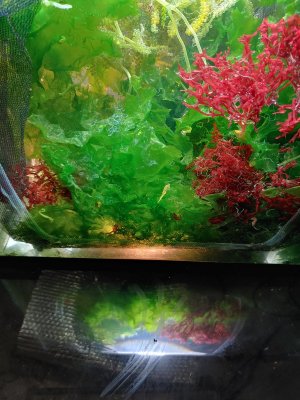
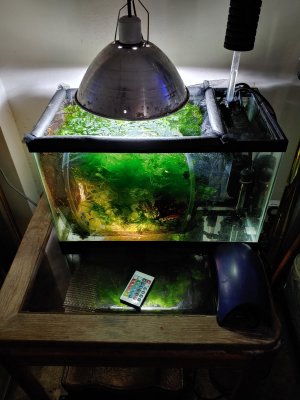
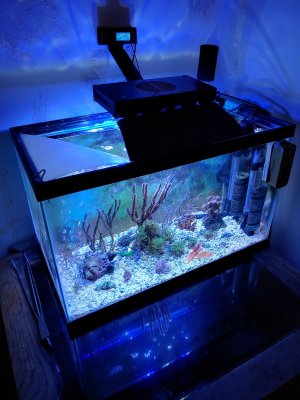
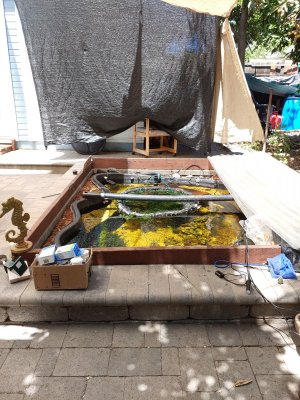
This article is one of a few that gives a real in depth look at requirements and care of seahorses. Honestly, this is one of the articles I saved as a favorite in my web browser because it got me into wanting to start a seahorse tank 
Thank you for the kind words. Seahorses are awesome but they are not for every aquarist.This article is one of a few that gives a real in depth look at requirements and care of seahorses. Honestly, this is one of the articles I saved as a favorite in my web browser because it got me into wanting to start a seahorse tank
- Joined
- Dec 1, 2019
- Messages
- 2,694
- Reaction score
- 11,005
I love everyone of my ponies 34 total all H. ErectusThank you for the kind words. Seahorses are awesome but they are not for every aquarist.
Great article and I look forward to reading the rest of the series!!!
Thank you. Yes seahorses are very special but not for the casual aquarist. When my last pony passed I was ready to have an easier aquarium to maintain. I surely do miss them at times though.Excellent article,very informative.That said I give kudos to anyone who is attempting and nurturing seahorses.
Nice work.
Ive kept happy horses previously. Lately they have been so difficult to obtain in the EU that Ive started what will hopefully be a breeding programme.
I suspect I shall start to log in here eventually if things progress. I already have a big fan cooling the water to keep it under 24 C, Spain has had temps in the 90's already this year. Altho I can 'jiggle things about' I suspect I will indeed have to invest in a small chiller. Ive actually seem some 50gallon size ones for 200 euros/pounds/dollars or so
Ive kept happy horses previously. Lately they have been so difficult to obtain in the EU that Ive started what will hopefully be a breeding programme.
I suspect I shall start to log in here eventually if things progress. I already have a big fan cooling the water to keep it under 24 C, Spain has had temps in the 90's already this year. Altho I can 'jiggle things about' I suspect I will indeed have to invest in a small chiller. Ive actually seem some 50gallon size ones for 200 euros/pounds/dollars or so
FWIW, sometimes it's cheaper to just air condition the room they are in if possible.
My abdominalis seahorses need temps 20°C or lower so I bought a used 5,000BTU AC unit to cool their area. It was $50 CDN.
My abdominalis seahorses need temps 20°C or lower so I bought a used 5,000BTU AC unit to cool their area. It was $50 CDN.


















